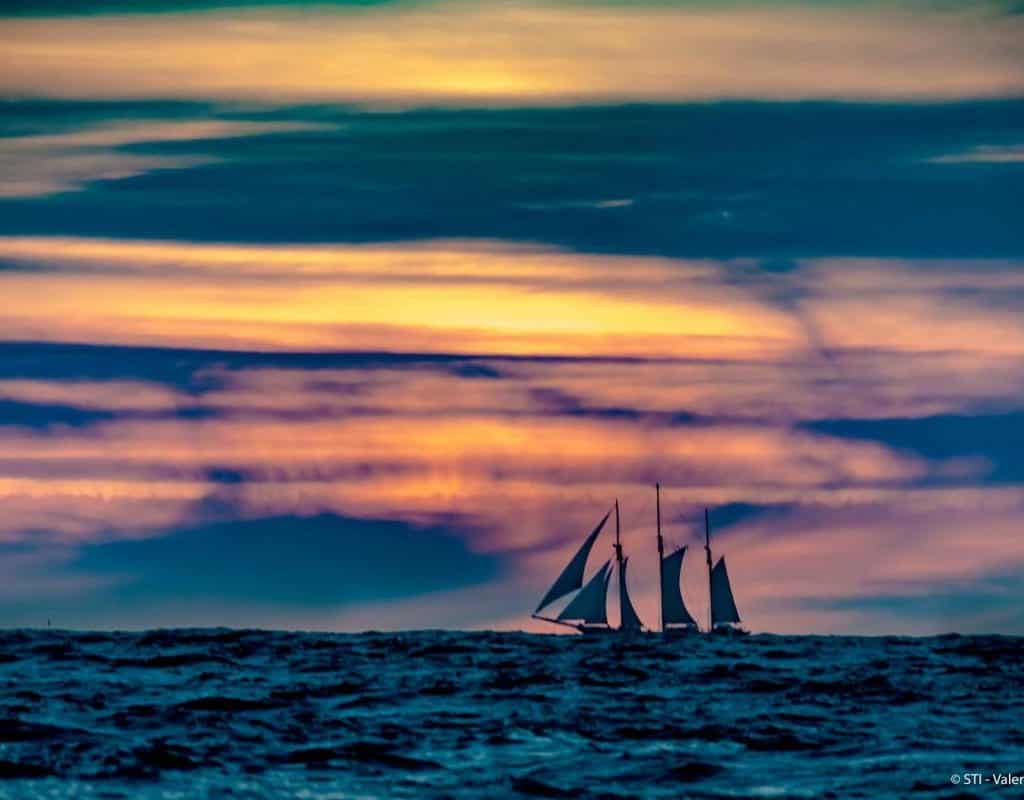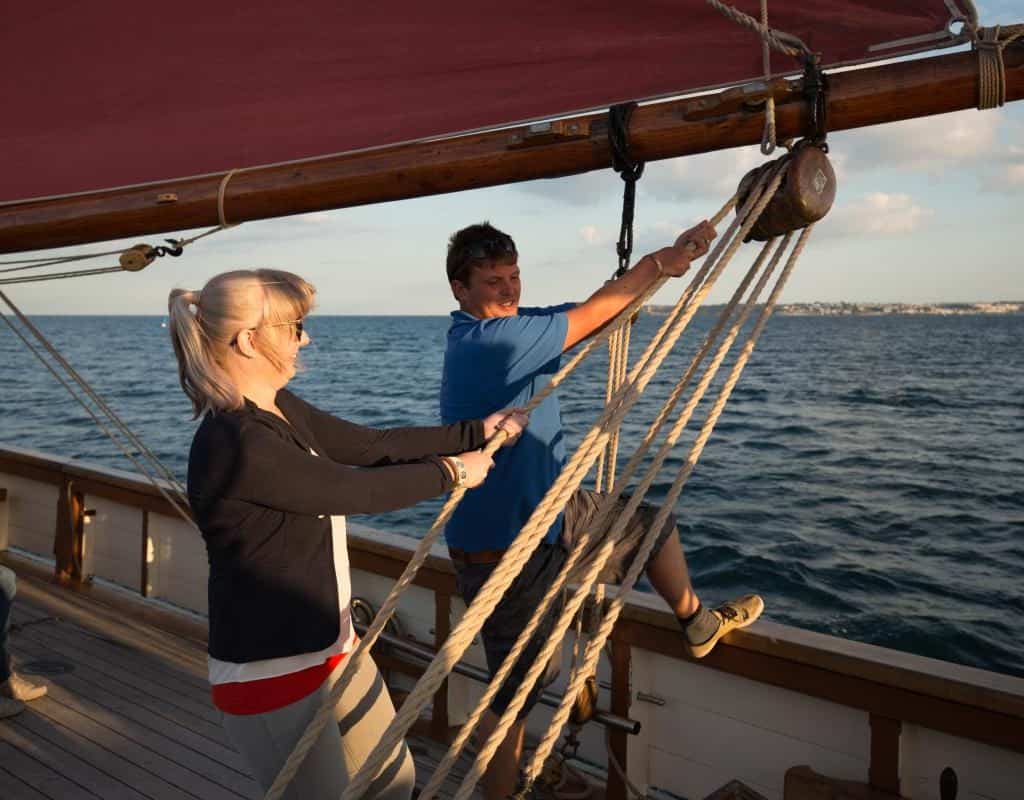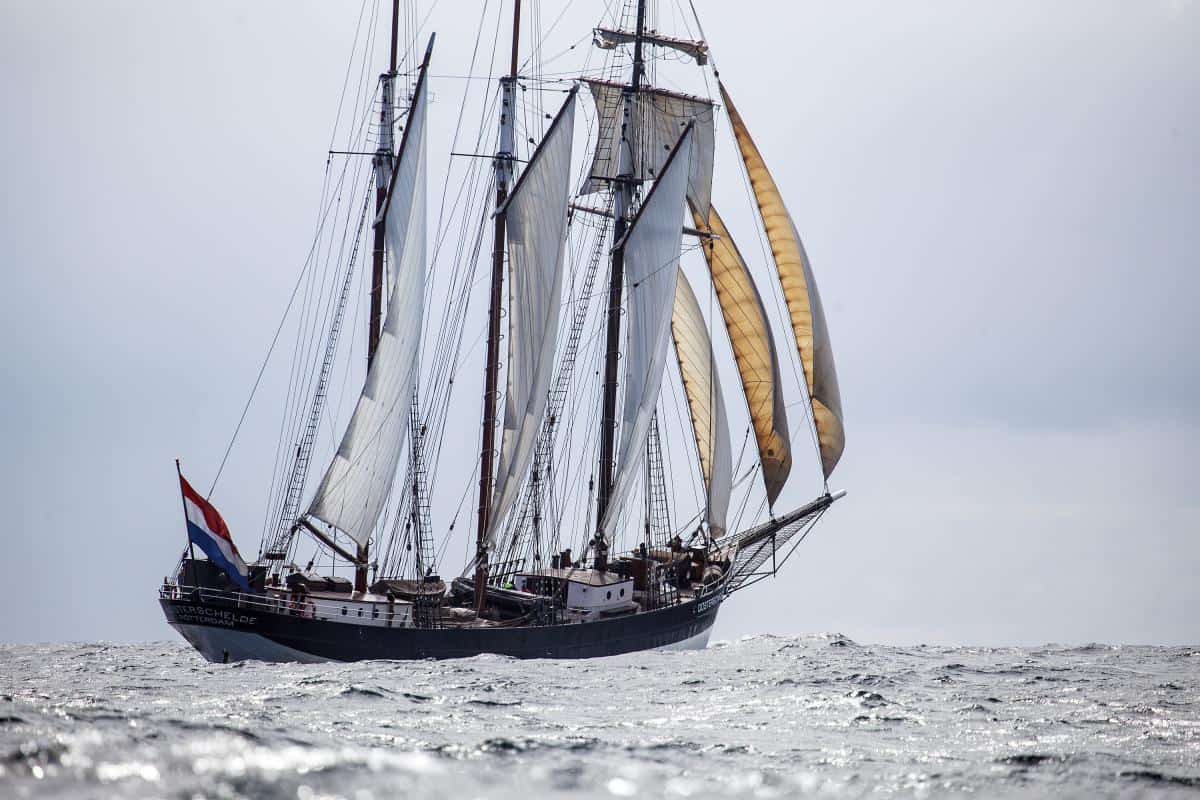Brilliant Coastal Sailing
Voyages that follow the coast, and start in one port and end in another, offer a real exploration journey where there are new sights around every headland.
9 Great Reasons why Coastal Sailing is brilliant
- Lots of Variety – never boring
- The excitement of what might be around the next headland
- A series of passages and stops towards your final destination
- Learn about navigation, tides and voyage planning choices.
- New Ports and anchorages that need pilotage plans
- Some night sailing and continuous sailing but not for days on end
- More challenge to sail the boat in a small watch whilst others rest
- Great for intermediate sailors wanting more challenging conditions
- Appeal to romantics who feel a sailing vessel should be travelling somewhere rather than anywhere.
How Hard is Coastal Passage Making?
It depends on weather, location, time of year, distance to travel in the timescale available, skill of the skipper, strength of the crew, size of the boat. In short it can be impossible to grade it in terms of challenge and good sailing potential.
At Classic Sailing we use all the experience we have in our office team to give you realistic and honest advice on our website about every voyage, likely route and range of weather to expect. With a coastal voyage sailing from one port to another if the vessel operator intends for the ship to sail without stopping on route then it is generally called a mile builder or delivery voyage. We don’t often feature these voyages as we are in the business of selling sailing holidays where the joy is in actually exploring the coast you are sailing along.

“So it is Coastal Hopping then?”
Yes, but the lengths of the hops can vary. We try to give you an idea of the pace of the voyage and where you might stop in the timescale in our website voyage descriptions. It can only ever be an educated guess of what might be in the actual skippers mind but we are pretty good at anticipating likely places they might aim for, and ports they will find hard to resist. Mel, Debbie and Adam in the Classic Sailing Office have all been charter skippers that have worked with novice crews for years. Becky is in weekly contact with each vessel operator so we are a bit more than just booking agents giving you a rosy marketing view.
If you know whats coming next, its not an adventure
With a coastal voyage that aims to sail from A to B, the skipper will have ‘getting there in time for the end date’ at the back of their mind. Plans can change frequently with weather forecasts, and he or she will also be looking to maximise opportunities to have a great time on route. As guest crew you need to have a flexible approach to go with every sail change, or decision to use the ‘donkey’ (engine) if that is the only way to make progress. As all our vessels are there for you to have a holiday on these journeys, they are generally designed with plenty of time to get to the end port in a pleasant way but the pace of the voyage will be more challenging and hours sailing typically longer than our coastal wandering voyages.

What is the Difference Between A Coastal Voyage and a Offshore Voyage ?
If a voyage from A to B involves sailing more than 12 miles from the coast (i.e. a point where you might start to go out of sight of land) then it becomes an offshore passage rather than an inshore coastal passage. A lot of our voyages that take you on a journey between ports, involve a mix of coastal hopping in sight of land and longer offshore passages like Land’s End to Pembrokeshire or a Channel crossing before exploring Brittany coast or delivering cargoes. Sometimes being near the land gives you more shelter. Sometimes it can be more dangerous than the open sea, but generally the weather and seas gets more extreme as you head further offshore. You can have a balmy flat offshore passage for a hundred miles and nasty wind against tide rough seas within 10 miles of port.
You just need to have a bit more stamina and resilience to cope with rough weather for longer periods if your route has to cross big stretches of coast without shelter or ports.

Will I be Seasick?
On a locally based coastal wandering break with no distant port to reach, if the crew start to look a bit green then the skipper can try sailing a different direction across the waves or duck into flatter water in an estuary or river. Seasickness can generally be avoided. Once there is an intention to journey along the coast more than 20 miles then it might be a few hours before you reach flat water, so a this may be your first real test. It could also be the right length of voyage for you to discover that your body does adapt to the motion and you will now have the confidence to go further afield. If you do feel seasick, once you step on land it miraculously goes away, so the pathway to training your sea legs and mind to be immune to seasickness is through coastal journeys and a bit of determination rather than day days.
If you are relatively new to sailing or prone to seasickness, then choosing the right coastal journey is not always easy. This is when you would really benefit from ringing Debbie or Adam for a frank assessment of what voyage might be best to ‘stretch you’ but not stress you.
What Is a Mile Builder Voyage?
If a voyage along the coast mentions ‘milebuilder’ then you really are helping the ship re position to another port as a primary objective. They tend to be cheaper and are often good for career sailors as a way of getting to know the ship and professional crew. Itineraries for these can be tight or have good time margins built in. It could be amazing experience sailing all the way with time to stop for a swim or a beer in port on the way, or it might involve continuous sailing or motoring day and night to get there on time.
If you sail on a mile builder promoted on Classic Sailing website, you are still guest crew and they are booked in the same way under normal terms and conditions. Training and everything you are expected to do should be the same as any other voyage. It is possible you might get to the destination port early which means you can explore ashore with the ship as your base, but it is unlikely the ship will sail around island hopping.
If you every get asked to be ‘delivery crew’ on a vessel this is a very different thing from what Classic Sailing provide as you may potentially be part of the professional crew with the responsibilities that go with that.




